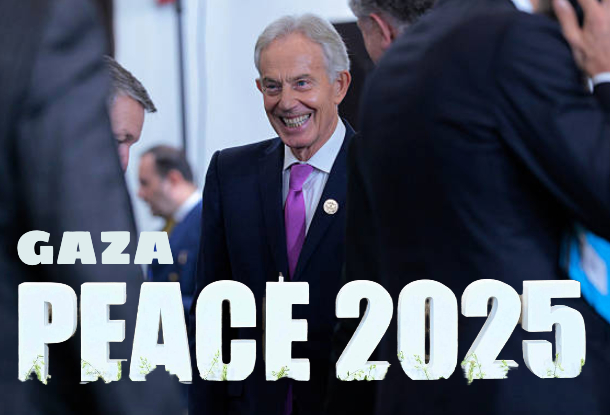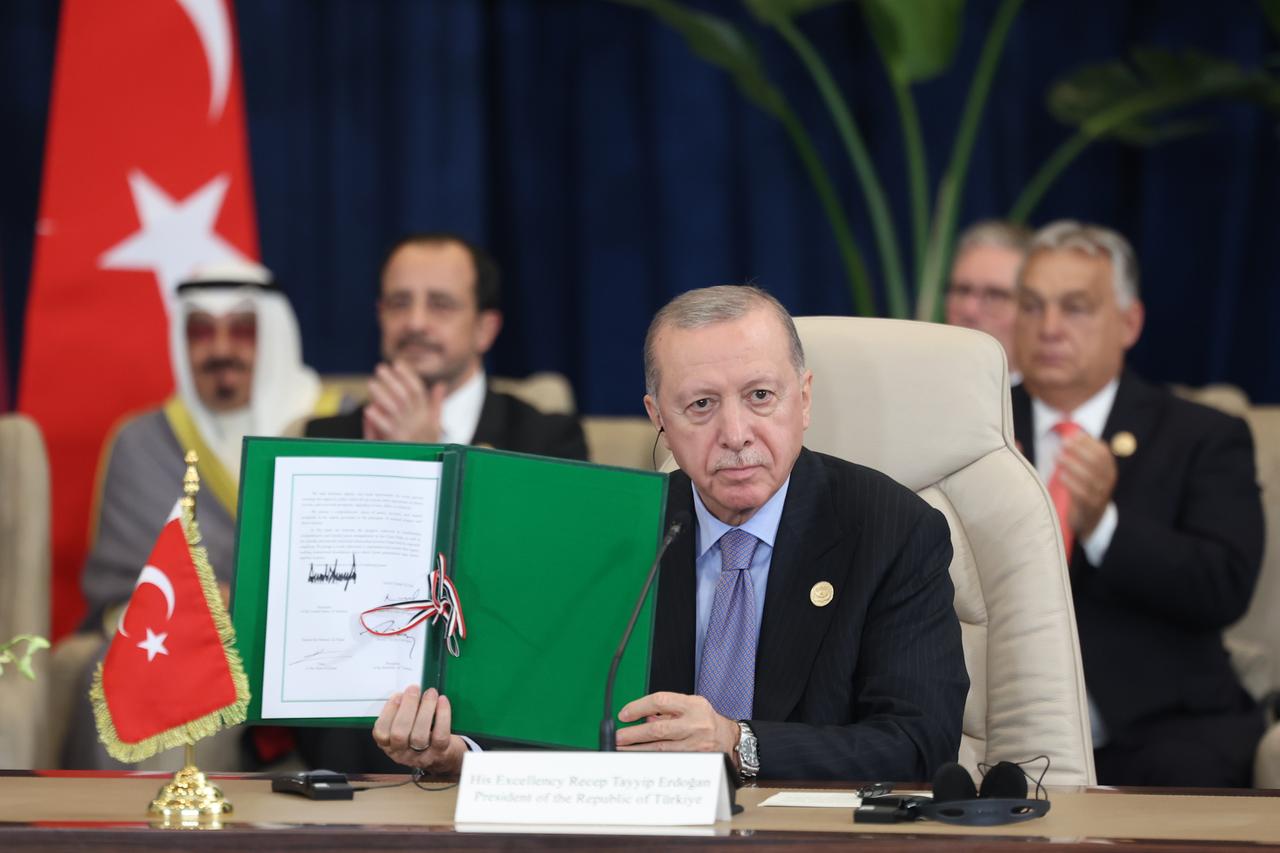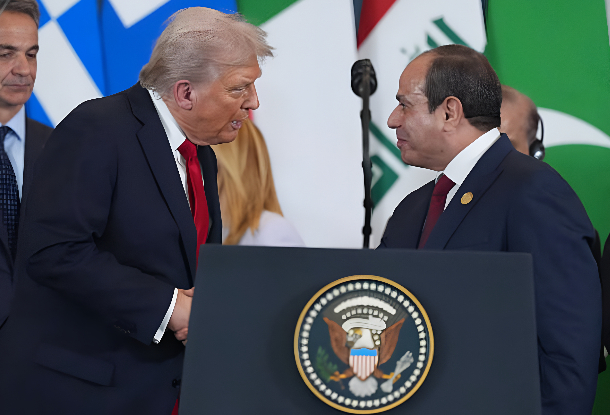2025 Gaza Peace Summit: A Show Without Substance

IMAGE: Former Prime Minister of the United Kingdom Tony Blair attends a ceremony for the signing of a Gaza ceasefire agreement on October 13, 2025, in Sharm El-Sheikh, Egypt (Source: Getty Images)
Earlier on Monday, President Trump and Egypt’s President Sisi welcomed over 20 global leaders, including Turkey’s President Recep Tayyip Erdogan, to the Egyptian resort town of Sharm el-Sheikh for a summit aimed at finalizing a ceasefire agreement for Gaza. The agreement was signed by Erdogan, Trump, Sisi, and the Emir of Qatar, Sheikh Tamim bin Hamad Al Thani, while representatives from Israel and Palestine were conspicuous by their absence.
VIDEO: Egyptian President Abdel Fattah el-Sisi and his American counterpart, Trump, finalizing a ceasefire agreement between Israel and Hamas.
.
Reports suggest that Israeli Prime Minister Netanyahu cancelled his attendance at the Gaza peace summit in Sharm el-Sheikh after Iraq and Turkey opposed his presence, pressuring Egypt to withdraw his invitation. Although the summit aimed to support a Gaza ceasefire and reconstruction, Turkey threatened to boycott, and Iraq warned it would withdraw if Netanyahu attended, leading Egypt to inform the Israeli Prime Minister that his presence was no longer required. Turkish President Recep Tayyip Erdogan, who has a significant political interest in satisfying a large pro-Palestinian crowd back home, stated on Friday that a resurgence of conflict in Gaza would “incur a substantial cost.”

IMAGE: President Recep Tayyip Erdogan signing Gaza ceasefire deal at the Sharm El-Sheikh Peace Summit in Sharm El-Sheikh, Egypt, Oct. 13, 2025. (Source: Turkish Presidency/Mustafa Kamaci)
Beneath this public relations vaudeville produced by another “coalition of the willing”, where Trump is once again portrayed as the peacemaker, if not the saviour of the Middle East, lies a crucial truth that needs to be expressed. Many experts from across the geopolitical chessboard concede that the ongoing conflicts in the Middle East/West Asia, spanning Iraq, Lebanon, Syria, Yemen, and Gaza, are not standalone wars but rather elements of a continuous strategy aimed at dismantling the Axis of Resistance. This coalition, led by the US, Israel, and Gulf monarchies, seeks to eradicate any state or movement that poses a challenge to their dominance. With a bit of clarity and research, it becomes evident that the 2003 invasion of Iraq was meant to cut Iran’s regional ties and isolate Tehran, with Saudi Arabia and Israel playing a significant role by providing political backing and operational intelligence to destabilize Iraq.
Moreover, it is crucial to understand that Israel’s attacks on Lebanon targeting Hezbollah are part of a broader effort for Israel to reclaim its regional supremacy. Meanwhile, the conflict in Syria that erupted in 2011 was a collaborative effort by the US, Israel, and the GCC to disrupt Iran’s relationships with its allies. Similarly, Saudi Arabia’s military intervention in Yemen, which began in 2015 and received US support, was not only aimed at defeating Ansar Allah, who resist US-Israeli control over Red Sea trade routes, but also intended to weaken and reduce Iran’s sphere of influence in the region.
Today, there is ample evidence which suggests that the ongoing conflict in Gaza perpetuates this agenda, with Israel aiming to eradicate Hamas and establish normalized relations with Arab regimes, supported by Gulf states that publicly denounce Hamas while covertly undermining Palestinian resistance.
Together, Israel and the Gulf countries form a cohesive alliance aimed at countering the Axis of Resistance through a combination of political, military, and media tactics. This alliance is exactly what gave birth to a new paradigm, where a peace deal agreement can be signed publicly for all to see, yet excludes the very people who will be affected and bound by it. It is truly astonishing.
How can this be called a peace summit when not a single representative from the resistance, the very forces fighting Israel, whether Iran, Hezbollah, Yemen, Hamas, or the Iraqi movements, is present?
All the attendees already have peace deals with Israel, whether publicly or… pic.twitter.com/6iP8z5bRjQ
— Ibrahim Majed (@ibrahimtmajed) October 13, 2025
Guest on 21st Century Wire Show, political analyst based in Beirut, Ibrahim Majed, wrote the folwing in a recent post on X:
“The so-called peace summit is, in truth, a dress rehearsal for war. Washington and Tel Aviv are not pursuing reconciliation so much as the neutralization of resistance forces through engineered instability. Their strategy is indirect: provoke civil strife and social unrest across the resistance axis to force internal fragmentation and compel local institutions to confront their own movements.”
While being entertaining, many saw the peace summit more as an act of submission rather than a genuine quest for compromise. If one were to look closer, one would see that this so-called peace deal is nothing short of a geopolitical instrument aimed at reinforcing external dominance by fracturing the unity of resistance groups while engineering the return to the Abraham Accords.
The summit in Egypt, spearheaded by Trump, concentrated on achieving a ceasefire and providing aid, yet it deliberately steered clear of directly addressing Palestinian statehood and the disarmament of Hamas. Consequently, the fundamental issues remain unresolved for the time being…

IMAGE: President Donald Trump speaks with Egypt’s President Abdel-Fattah el-Sissi during a summit of European and Middle Eastern leaders on Gaza on October 13, 2025 in Sharm El-Sheikh, Egypt (Source: Getty Images)
Vinod Janardhanan reports for WION…
Gaza ‘Trump peace summit’ in Egypt a circus or mere show? No commitments on Palestine statehood or Hamas disarmament leaves key questions unsolved
Two of the key aspects of Israel’s war in Gaza were the future of Palestinian statehood and the disarming of Hamas. Neither of these were prominently mentioned at the peace summit in Egypt aimed at ending the Israel-Hamas war ongoing since 2023. This has left the core issues unresolved, leaving room for future conflicts.
Much of what happened at Sharm el-Sheikh on Monday (Oct 13) was about Donald Trump. Israeli Prime Minister Benjamin Netanyahu was not present; reportedly, Turkey’s Erdoğan successfully discouraged Trump from inviting him to Egypt. Palestinian Authority President Mahmoud Abbas was present, but he does not control Gaza; Hamas does. It is not clear who represented Hamas, as much of its political and military leadership was wiped out by Israel during the war.
Gaza peace summit: What happened at Sharm El-Sheikh?
The Sharm El-Sheikh Summit was co-chaired by Donald Trump and Egyptian President Abdel Fattah el-Sisi, and attended by leaders of more than 20 countries to endorse the first phase of a US-brokered Gaza ceasefire and peace plan agreed by Hamas and Israel on October 8. The summit happened even as all 20 living Israeli hostages held by Hamas were released in exchange for over 1,900 Palestinian prisoners from Israel. On record, the summit’s focus was on international backing for the ceasefire, future governance of Gaza, security, and humanitarian aid.
A symbolic event without any real value?
With neither belligerent of the war fully present, the summit was mostly a symbolic signing ceremony for the initial phase of the ceasefire plan. The most important questions remained unanswered: full Israeli withdrawal, Gaza reconstruction, which is estimated to cost around $53 billion, and post-war governance. Those matters, it appears, will be tackled in future negotiations.
Gaza peace summit: Was there a final text, communiqué, resolution, or joint statement?
The summit produced two primary documents:
1. The Trump Declaration for Enduring Peace and Prosperity, which was dubbed as the “peace document” or “agreement,” was signed by the US president, el-Sisi, and leaders from Qatar and Turkey. The language was broad, containing commitments to support the ceasefire and stressing regional stability, security, and economic prosperity. This largely symbolic document focused on upholding the first phase of the peace plan. It did not delve into specifics regarding Gaza’s governance or the disarmament of Hamas and other armed groups.
2. A joint statement was issued by Trump, Qatar, Egypt, and Turkey. This statement was also vague about Palestinian statehood or Hamas disarmament. It stressed “equality between Israelis and Palestinians,” a vision of “tolerance, dignity, and equal opportunity for every person… regardless of race, faith, or ethnicity.” It also spoke of collective efforts to end the war and foster peace.
Absent from the proceedings or documents of the summit were any binding resolutions on the most contentious issues.
Verbal assurances and warnings on Palestinian statehood
The documents and summit discussions included indirect references to Palestinian statehood, but nothing explicit. Egyptian President el-Sisi explicitly warned during the summit that “only the creation of a Palestinian state could offer a durable end to the conflict.” The joint statement’s stress on equality between Israelis and Palestinians was interpreted by some analysts as a subtle nod to statehood aspirations, as was the presence of Mahmoud Abbas.
Most of the summit remarks and documents prioritised cessation of hostilities over political changes on the ground for Palestinians. Implementation of the ceasefire appeared more important than addressing deeper political issues.
Was there any mention of Hamas or its disarmament?
Interestingly, the documents avoided direct mentions of Hamas by name. Thus, the main actor of the war was absent from the summit, having relied on Qatari and Egyptian mediators. There was no explicit condemnation of the 7 October 2023 terror attack by Hamas on Israel that set off the war. The signed declaration and joint statement did not mention Hamas but praised “regional leaders” (implicitly including Qatar and Egypt) for brokering the deal with Hamas and acknowledged their “very important role.”
The texts did not include binding language on Hamas disarmament, which remains a sticking point earmarked for later phases of negotiations.
But prior to the Egypt summit, Hamas had outrightly rejected disarmament as “out of the question.” Germany’s Foreign Minister, Annalena Baerbock, stated that some states were “exerting pressure on Hamas to disarm for further talks.”
The Egypt declaration focused on “security” broadly, leaving disarmament and Hamas’s future role, such as its exclusion from Gaza governance for future negotiation.
The one clear achievement was to secure the international community’s approval for the truce, with optimism that it would hold. As for the rest, it was largely a procedural and symbolic event intended for optics. While celebrating the ceasefire’s start, the summit deferred thornier issues like Palestinian statehood and Hamas disarmament to future talks, possibly to avoid derailing momentum for peace on the ground.
In short, Gaza now has a fragile peace, and the Egypt summit left several crucial questions unanswered. Let’s wait for phase two of the talks.
READ MORE CEASEFIRE NEWS AT: 21st CENTURY WIRE CEASEFIRE FILES
SUPPORT OUR INDEPENDENT MEDIA PLATFORM – BECOME A MEMBER @21WIRE.TV
VISIT OUR TELEGRAM CHANNEL
21st Century Wire is an alternative news agency designed to enlighten, inform and educate readers about world events which are not always covered in the mainstream media.
Source: https://21stcenturywire.com/2025/10/14/2025-gaza-peace-summit-a-show-without-substance/
Anyone can join.
Anyone can contribute.
Anyone can become informed about their world.
"United We Stand" Click Here To Create Your Personal Citizen Journalist Account Today, Be Sure To Invite Your Friends.
Before It’s News® is a community of individuals who report on what’s going on around them, from all around the world. Anyone can join. Anyone can contribute. Anyone can become informed about their world. "United We Stand" Click Here To Create Your Personal Citizen Journalist Account Today, Be Sure To Invite Your Friends.
LION'S MANE PRODUCT
Try Our Lion’s Mane WHOLE MIND Nootropic Blend 60 Capsules
Mushrooms are having a moment. One fabulous fungus in particular, lion’s mane, may help improve memory, depression and anxiety symptoms. They are also an excellent source of nutrients that show promise as a therapy for dementia, and other neurodegenerative diseases. If you’re living with anxiety or depression, you may be curious about all the therapy options out there — including the natural ones.Our Lion’s Mane WHOLE MIND Nootropic Blend has been formulated to utilize the potency of Lion’s mane but also include the benefits of four other Highly Beneficial Mushrooms. Synergistically, they work together to Build your health through improving cognitive function and immunity regardless of your age. Our Nootropic not only improves your Cognitive Function and Activates your Immune System, but it benefits growth of Essential Gut Flora, further enhancing your Vitality.
Our Formula includes: Lion’s Mane Mushrooms which Increase Brain Power through nerve growth, lessen anxiety, reduce depression, and improve concentration. Its an excellent adaptogen, promotes sleep and improves immunity. Shiitake Mushrooms which Fight cancer cells and infectious disease, boost the immune system, promotes brain function, and serves as a source of B vitamins. Maitake Mushrooms which regulate blood sugar levels of diabetics, reduce hypertension and boosts the immune system. Reishi Mushrooms which Fight inflammation, liver disease, fatigue, tumor growth and cancer. They Improve skin disorders and soothes digestive problems, stomach ulcers and leaky gut syndrome. Chaga Mushrooms which have anti-aging effects, boost immune function, improve stamina and athletic performance, even act as a natural aphrodisiac, fighting diabetes and improving liver function. Try Our Lion’s Mane WHOLE MIND Nootropic Blend 60 Capsules Today. Be 100% Satisfied or Receive a Full Money Back Guarantee. Order Yours Today by Following This Link.






